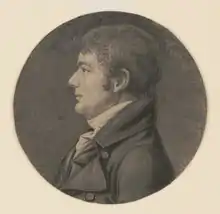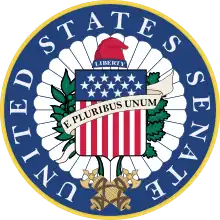John Wayles Eppes
John Wayles Eppes (April 1772 – September 13, 1823) was an American lawyer and politician. He represented Virginia in the U.S. House of Representatives from 1803 to 1811 and again from 1813 to 1815. He also served in the U.S. Senate (1817–1819). His positions in Congress occurred after he served in the Virginia House of Delegates representing Chesterfield County (1801–1803).[1]
John Wayles Eppes | |
|---|---|
 | |
| United States Senator from Virginia | |
| In office March 4, 1817 – December 4, 1819 | |
| Preceded by | Armistead T. Mason |
| Succeeded by | James Pleasants |
| Member of the U.S. House of Representatives from Virginia's 16th district | |
| In office March 4, 1813 – March 3, 1815 | |
| Preceded by | James Pleasants |
| Succeeded by | John Randolph |
| In office March 4, 1803 – March 3, 1811 | |
| Preceded by | Anthony New |
| Succeeded by | James Pleasants |
| Member of the Virginia House of Delegates representing Chesterfield County | |
| In office December 7, 1801 –1803 | |
| Preceded by | Thomas Augustus Taylor |
| Succeeded by | Isaac Salle |
| Personal details | |
| Born | April 1772 Eppington, Virginia Colony, British America |
| Died | September 13, 1823 (aged 51) Buckingham County, Virginia, U.S. |
| Political party | Democratic-Republican |
| Spouses | |
| Children | 9, including Francis W. Eppes |
| Alma mater | Hampden–Sydney College |
| Profession | Lawyer, planter, politician |
Early life and education
Eppes was born in April 1772 at Eppington, in Chesterfield County in the Colony of Virginia, the sixth child and only son of Elizabeth (née Wayles) and Francis Eppes, who would serve one term in the House of Delegates a decade later.[2] A member of the First Families of Virginia, he was related through both his parents to Martha Jefferson, his mother's half-sister and the wife of Thomas Jefferson, with whom Eppes was close.[3][1]
After being taught by tutors as was customary in his planter class, Eppes attended the University of Pennsylvania at Philadelphia, and graduated from Hampden–Sydney College in Virginia in 1786. He studied law and was admitted to the bar in 1794, commencing practice in the state capital, Richmond.
Marriage and family
Eppes married his first cousin Mary Jefferson (known as "Polly" in childhood and "Maria" as an adult) on October 13, 1797, at Monticello.[1] They resided at Mont Blanco plantation in Chesterfield County, Virginia.
After several miscarriages and the death in January 1800 of a newborn baby girl,[4] Maria and John had two children:[3]
- Francis Wayles Eppes (September 1801 – May 1881)
- Maria Jefferson Eppes (February 1804 – February 1806)
Mary died at Monticello on April 17, 1804, two months after the birth of Maria, and is buried there.[3][5]
On April 15, 1809, Eppes married Martha Burke Jones, daughter of Willie Jones, a prominent North Carolina planter and politician. They had six children.[1]
Betsy Hemmings
After Mary's death, Eppes moved his household and slaves from Mont Blanco to another of his plantations called Millbrook in Buckingham County, Virginia. Among the slaves was Betsy Hemmings, the mixed-race daughter of Mary Hemings and granddaughter of Betty Hemings.[6][7] According to her descendants, Hemmings became a concubine to Eppes in a relationship that began when he was a young widower. She bore his son, Joseph, likely named for her brother.[8] She named their daughter Frances,[6] a name traditional among men in the Eppes family.[7] She lived at Milbrook for the rest of her life,[9] and when she died in 1857, was buried next to John Wayles Eppes in the family cemetery there.[6][10]
Political career
Eppes was a member of the Virginia House of Delegates from 1801 to 1803 alongside Matthew Cheatham.[11] On March 4, 1803, he won election as a Democratic-Republican to the Eighth United States Congress and the next three succeeding Congresses, so he was frequently away from his plantations. He chaired the Ways and Means Committee for the Eleventh Congress but lost his re-election attempt so did not serve in the Twelfth, but instead spent the next two years at his Milbrook plantation.
Eppes won election to the Thirteenth Congress (March 4, 1813 – March 4, 1815) and again chaired the Committee on Ways and Means. After losing the election to the Fourteenth Congress, he was elected to the United States Senate and served from March 4, 1817, until December 4, 1819, when he resigned because of ill health. He chaired the Committee on Finance during the second session of the Fifteenth Congress.
Retirement and death
Late in life Eppes suffered from various ailments. He died at Millbrook on September 13, 1823, and was buried in the Eppes family cemetery at Millbrook.
References
- Looney, J. Jefferson and the Dictionary of Virginia Biography (April 14, 2016). "John Wayles Eppes (1772–1823)". Encyclopedia Virginia. Virginia Foundation for the Humanities. Retrieved January 10, 2019.
- Cynthia Miller Leonard, The Virginia General Assembly 1619-1978 (Richmond: Virginia State Library p. 141
- "Maria Jefferson Eppes", Thomas Jefferson Encyclopedia, Monticello website
- Kerrison, Catherine (2018). Jefferson's Daughters: Three Sisters, White and Black, in a Young America. Ballantine Books. ISBN 978-1-101-88624-3.
- "Persons Buried at the Monticello Graveyard, 1773 - 1997". Thomas Jefferson Encyclopedia - Monticello website. Thomas Jefferson Foundation. Retrieved January 17, 2020.
- Jacques, Edna Bolling. "The Hemmings Family in Buckingham County, Virginia". buckinghamhemmings.com. Retrieved January 10, 2019.
- "Betsy Hemmings", Hemings Family/People of the Plantation, Monticello, accessed February 14, 2011
- Annette Gordon-Reed, The Hemingses of Monticello, New York: W.W. Norton, 2008, Frontispiece: "The Hemings Family Tree-1," pp. 127-128
- "Betsy Hemmings: Loved by a Family, but What of Her Own?", Plantation & Slavery/Life after Monticello, Monticello, February 14, 2011
- Laura B. Randolph, "THE THOMAS JEFFERSON/SALLY HEMINGS CONTROVERSY: Did Jefferson Also Father Children By Sally Hemings' Sister?" Archived January 19, 2012, at the Wayback Machine, Ebony, February 1999, accessed February 16, 2011
- Leonard pp. 223, 227
External links
- United States Congress. "John Wayles Eppes (id: E000197)". Biographical Directory of the United States Congress.

